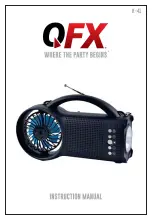
Charger compliance information
United States
This battery charger has been tested and found to
comply with the limits for a Class B digital device, in
accordance with part 15 of the FCC Rules.
These limits are designed to provide reasonable
protection against harmful interference in a
residential installation. This battery charger
generates, and can radiate, radio frequency energy.
If it is not installed and used in accordance with the
instructions, it may cause harmful interference to
radio communications. However, there is no
guarantee that interference will not occur. If this
charger does cause harmful interference to radio or
television reception (which can be determined by
turning the charger off and on), try to correct the
interference by:
!
Reorienting or relocating the receiving
antenna.
!
Increasing the separation between the equip-
ment and receiver.
!
Connecting the equipment into an outlet on
a circuit different from that to which the
receiver is connected.
!
Consulting the dealer or an experienced
radio/TV technician for help.
Canada
This Class B digital apparatus complies with
Canadian ICES-003.
Cet appareil numérique de la classe B est conforme
à la norme NMB-003 du Canada.
Summary of Contents for TP9100
Page 7: ......


























